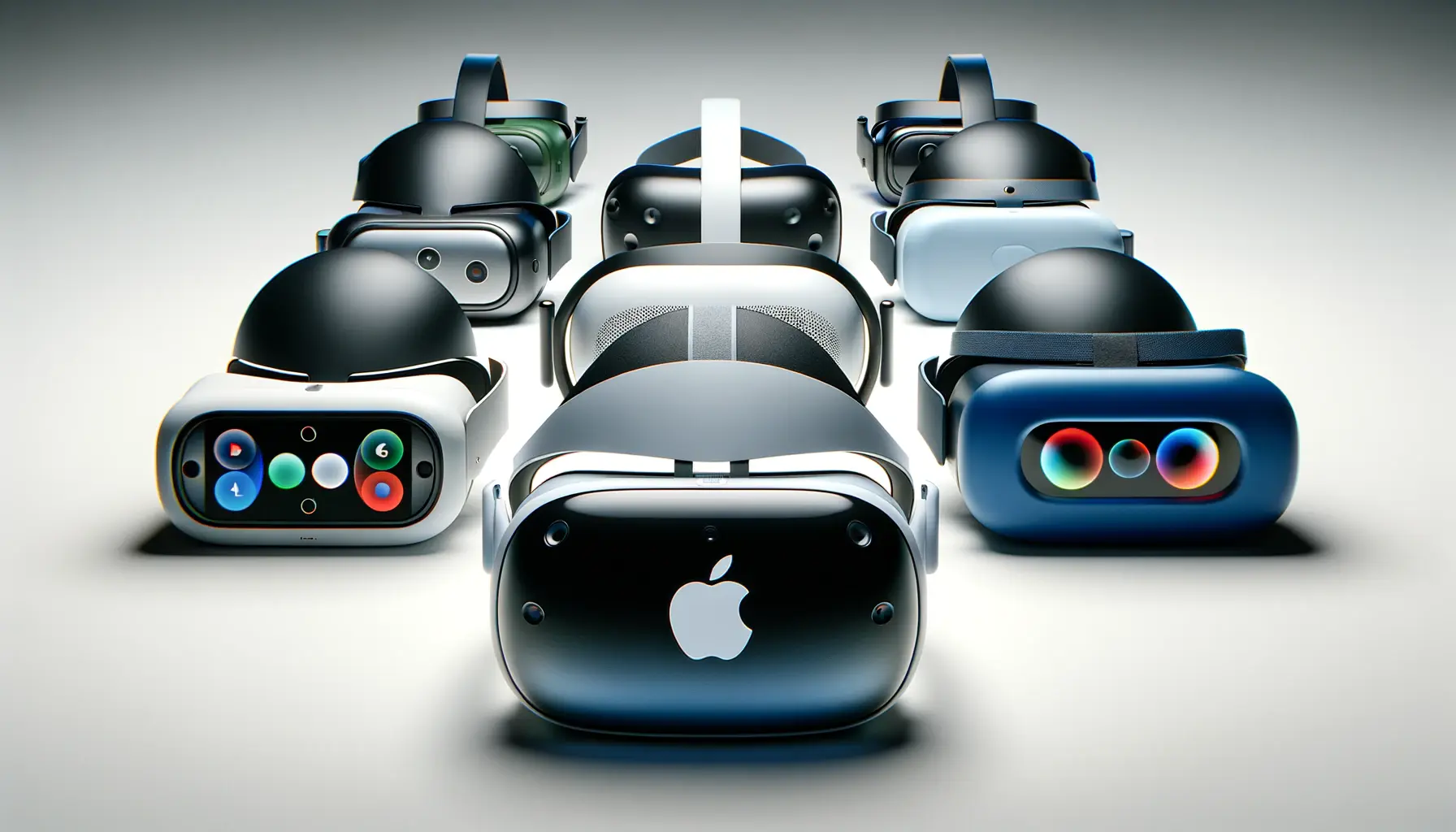In the world of digital advertising, the right platform can make or break your marketing strategy.
Two of the most prominent platforms, Bing Ads vs Google Ads, offer unparalleled opportunities for businesses to reach their target audience.
However, knowing the differences between these two platforms is crucial to maximize your ad spend and achieve the best results.
In this article, we will delve deep into the comparison of Bing Ads vs Google Ads, exploring their features, cost efficiency, and strategic advantages to help you make an informed decision.
- Market Reach and Audience Demographics
- Cost Efficiency and Return on Investment
- Ad Features and Targeting Capabilities
- Performance Metrics and Conversion Rates
- Strategic Recommendations for Advertisers
- Summary: Key Takeaways on Bing Ads vs Google Ads
- Frequently Asked Questions about Bing Ads vs Google Ads
Market Reach and Audience Demographics
When it comes to market reach and audience demographics, Bing Ads vs Google Ads offer distinct advantages that cater to different segments of users.
Understanding their reach and user profiles can help you align your advertising strategy with your business goals.

A visual representation of global search engine market share, highlighting Google’s extensive dominance and Bing’s significant presence in regions like North America and Europe.
Global Search Engine Market Share
Google dominates the search engine market with an estimated share of over 85%, making it the go-to platform for advertisers seeking massive exposure.
Bing, while smaller with approximately 6-7% of the market share, still holds a significant position, especially in regions like the United States where it powers searches for YahooA search engine and web services provider powered by Bing for its search functionality. and MSNMicrosoft Network, a web portal and collection of Internet services powered by Bing search. as well.
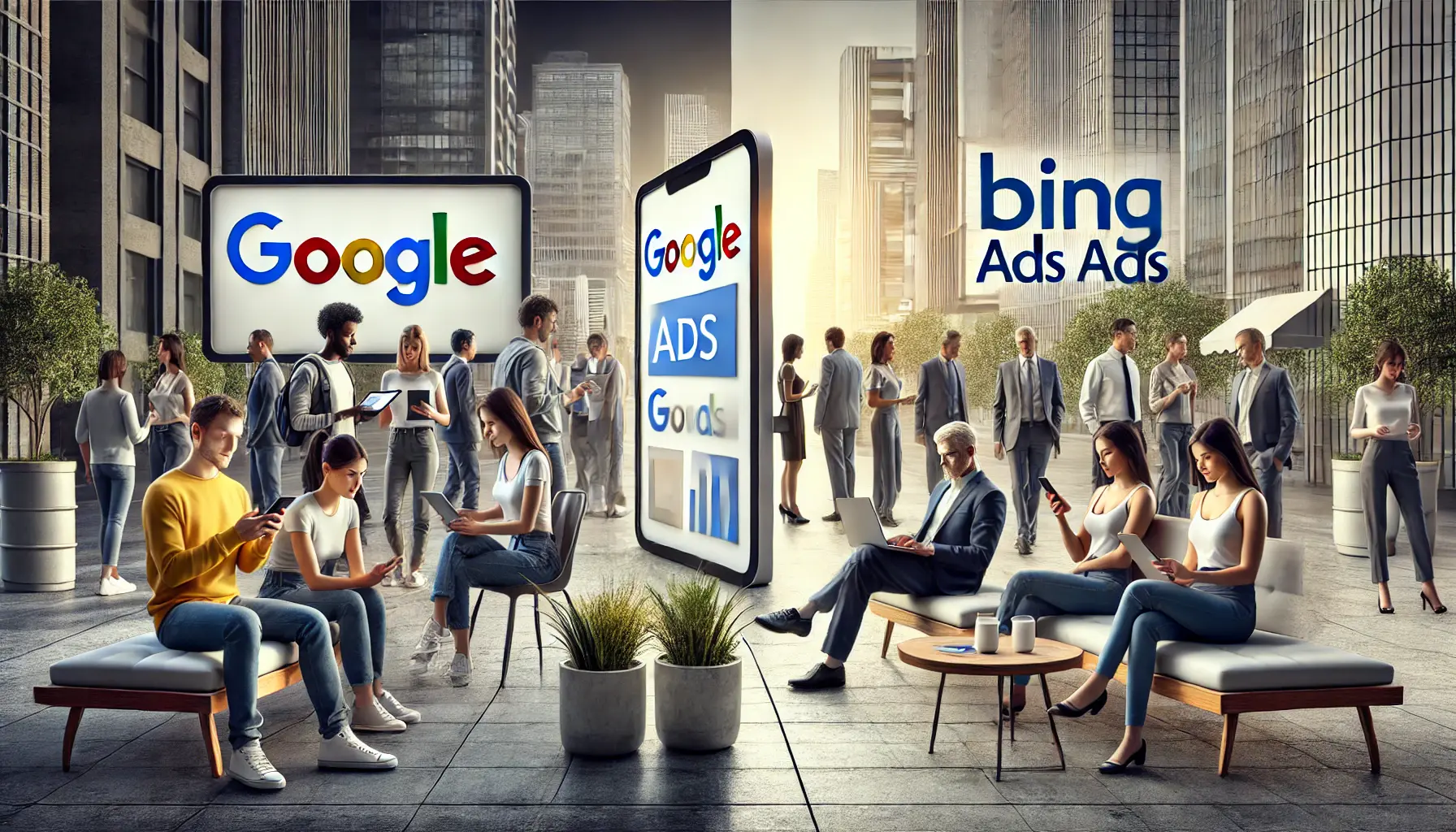
A depiction of user demographics and preferences, highlighting the contrast between Google Ads’ broad audience and Bing Ads’ professional user base.
User Demographics and Preferences
Bing Ads cater to a slightly older and more affluent audience compared to Google Ads.
This makes Bing an attractive option for businesses targeting professionals or older demographics with higher purchasing power.
Google, on the other hand, attracts a younger and broader audience, making it ideal for consumer-focused brands.

A stylized world map showcasing Bing’s strong user base in North America and Europe, contrasted with Google’s global dominance.
Geographical Distribution of Users
Bing’s user base is particularly strong in North America and Europe, whereas Google enjoys global dominance.
Businesses aiming to target audiences in specific regions, such as the U.S., might find Bing Ads a cost-effective choice.
For worldwide campaigns, Google Ads remains the better option due to its unparalleled reach.
By understanding the unique market reach and audience demographics of these platforms, you can better strategize your ad campaigns and achieve meaningful results.
In the next section, we’ll explore the cost efficiency and return on investment offered by Bing Ads vs Google Ads.
Bing Ads caters to an older, more affluent audience, while Google Ads appeals to a younger and broader demographic. Aligning your ad strategy with these insights can lead to better campaign outcomes.

A visualization of cost efficiency and return on investment, emphasizing the balance between financial savings and growth in digital advertising.
Cost Efficiency and Return on Investment
When evaluating Bing Ads vs Google Ads, understanding their cost structures and potential return on investment (ROIReturn on Investment, a measure of the profitability of an investment.) is crucial.
Both platforms offer unique advantages that can impact your advertising budget and overall campaign performance.
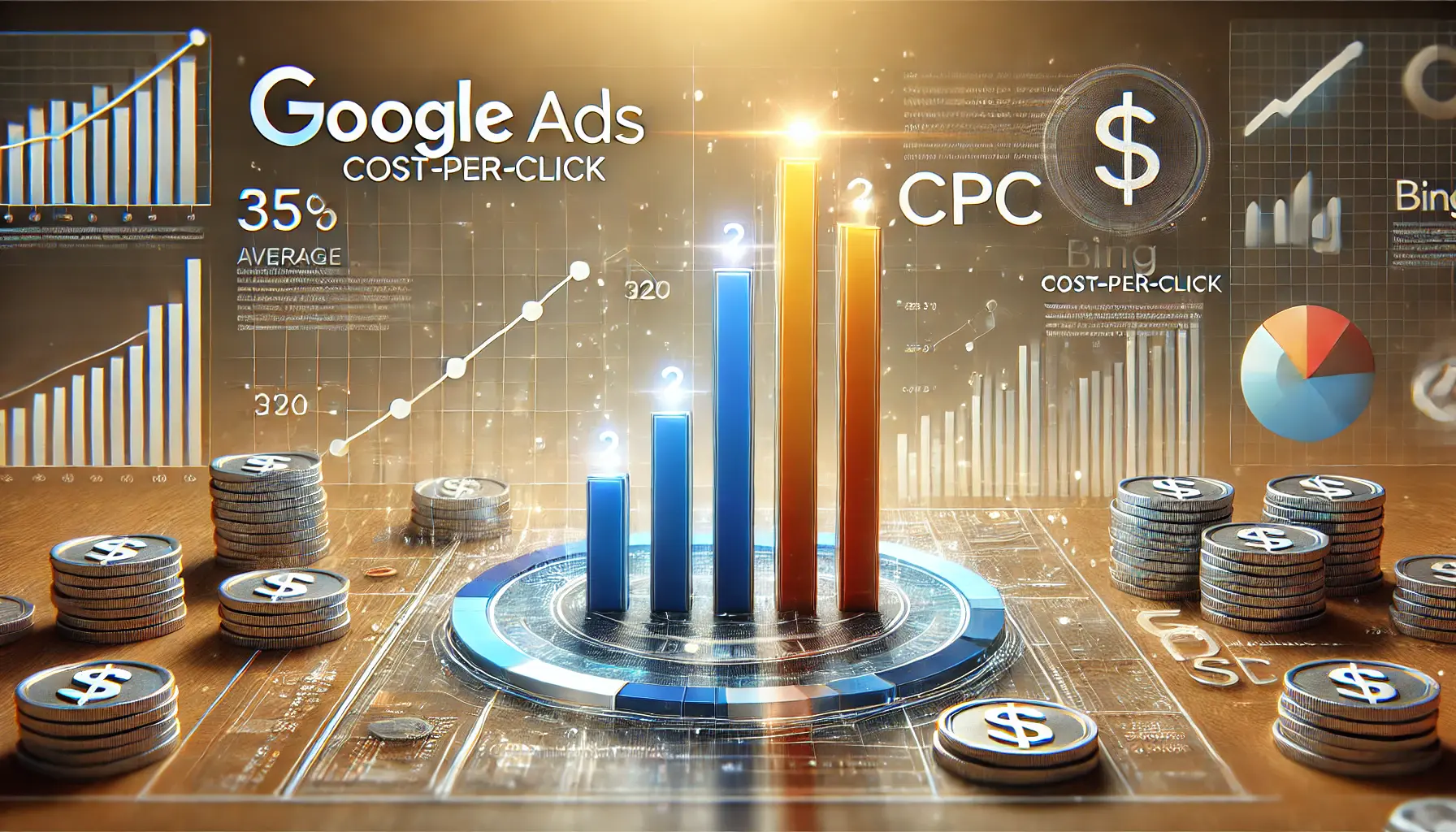
A visual comparison of average cost-per-click (CPC) between Bing Ads and Google Ads, highlighting cost differences.
Average Cost-Per-Click (CPC) Analysis
Cost-per-click (CPCCost-Per-Click, the amount an advertiser pays for each click on their ad.) is one of the key determinants of your ad spend.
In general, the average CPC on Bing Ads is lower than on Google Ads.
This is because there is less competition on the Bing network, and advertisers can obtain clicks at lower prices.
For example, some industries experience up to 70% lower CPCs on Bing Ads compared to Google Ads.

A visual representation of budget allocation strategies in digital marketing, highlighting approaches like testing, high-cost keywords, and platform combinations.
Budget Allocation Strategies
Given the cost differences, advertisers can develop strategic budget allocations to maximize ROI:
- Testing Campaigns: Start with a smaller budget on Bing Ads to test campaign performance before scaling.
- Competitive Keywords: Utilize Bing Ads for high-cost keywords that are more affordable on its platform.
- Combined Approach: Allocate budgets across both platforms to leverage Google’s extensive reach and Bing’s cost advantages.

A visual representation of assessing return on investment (ROI) in digital marketing, highlighting financial investment and performance evaluation.
Assessing Return on Investment (ROI)
A lower CPC on Bing Ads may lead to a higher ROI for companies targeting Bing’s user demographics.
However, the larger audience of Google Ads might result in higher overall conversions despite the higher cost.
Key performance indicators, such as conversion rates, cost per acquisition (CPACost Per Acquisition, the cost of acquiring one customer through advertising.), and overall ROI, should be monitored to decide where your advertising budget is best allocated.
By carefully analyzing the cost efficiency and ROI of Bing Ads vs Google Ads, you can make informed decisions that align with your marketing objectives and financial constraints.
In the next section, we’ll examine the ad features and targeting capabilities of both platforms to further guide your advertising strategy.
Consider starting with a smaller budget on Bing Ads for testing before scaling. Lower CPCs on Bing Ads can yield higher ROI in specific demographics.

A visual representation of ad features and targeting capabilities in digital marketing, showcasing various ad formats and targeting strategies.
Ad Features and Targeting Capabilities
When comparing Bing Ads vs Google Ads, it is crucial to understand the ad features and targeting capabilities that each platform offers.
Both provide a variety of ad formats and sophisticated targeting options, but there are notable differences that may influence your advertising strategy.
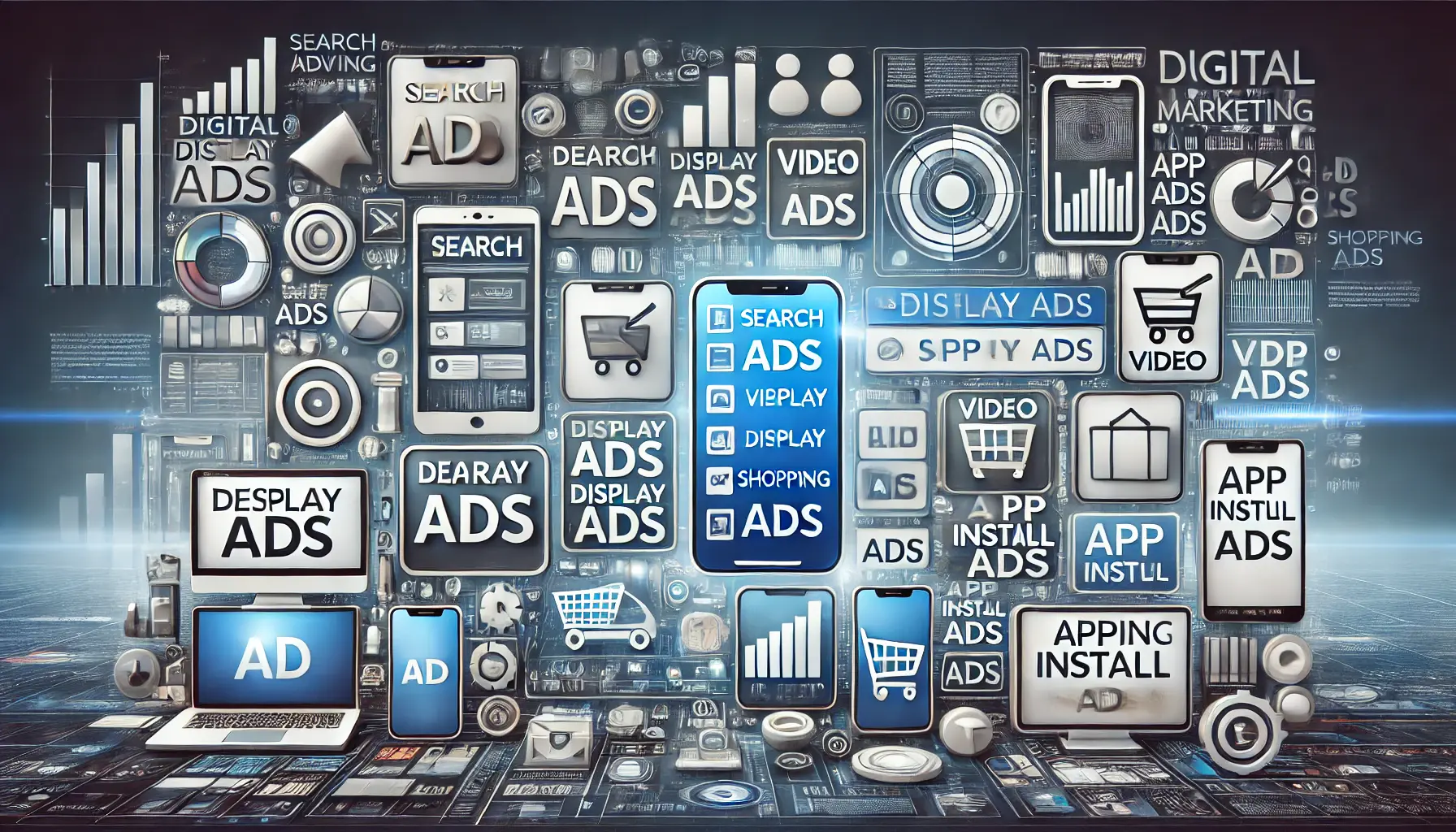
A visual representation of various ad formats in digital marketing, emphasizing the diversity of advertising options available.
Ad Formats
Both platforms offer a range of ad formats to cater to different marketing objectives:
- Search Ads: In-text ads featured on the result pages of search engines or browsers.
- Display Ads: Visual, graphical ads provided across a network of partner websites and portals.
- Shopping Ads: Product ads featuring images and prices displayed in online catalogs.
- Video Ads: Highly engaging video ads featured on platforms like YouTube (for Google) and the Microsoft Audience Network (for Bing).
- App Install Ads: Ads targeting users to encourage mobile application downloads.
While both platforms support these formats, Google Ads has a broader reach, especially with video ads on YouTube.
Bing Ads, however, offers unique formats like Multimedia Ads, which combine images and text for a richer experience.

A visual representation of targeting capabilities in digital advertising, showcasing options like demographics, location, device, and interest targeting.
Targeting Capabilities
Effective targeting ensures your ads reach the right audience.
Here’s how the platforms compare:
- Demographic Targeting: Both platforms allow targeting based on age, gender, and household income.
- Location Targeting: Ads can target users by country, region, city, or even a specific radius.
- Device Targeting: Options to target desktops, tablets, and mobile devices are available on both platforms.
- Remarketing: This feature allows you to re-engage users who have previously interacted with your website or app.
- In-Market Audiences: Target active customers who are researching or comparing products and services.
A unique feature in Bing Ads is LinkedIn Profile TargetingA feature in Bing Ads allowing advertisers to target users based on their LinkedIn profile details like job function or industry., which allows advertisers to target users based on their LinkedIn profiles, such as company, job function, and industry.
This is particularly beneficial for B2B campaigns.
On the other hand, Google Ads provides more granular targeting options and a wider user base, offering extensive reach and precision.
Understanding these ad features and targeting capabilities is essential in deciding the best platform for your advertising needs.
In the next section, we will analyze Bing Ads vs Google Ads regarding performance metrics and conversion rates to further refine your strategy.
Bing Ads’ LinkedIn Profile Targeting is a unique feature for B2B campaigns, while Google Ads excels in advanced machine learning and broader targeting options.

A visual representation of performance metrics and conversion rates in digital advertising, highlighting key indicators like click-through rate and conversion rate.
Performance Metrics and Conversion Rates
In the discussion of Bing Ads vs Google Ads, one key area to evaluate is performance metrics: click-through rates (CTRClick-Through Rate, the percentage of users who click on an ad after seeing it.) and conversion rates.
These metrics reveal how effectively each platform engages users and drives desired actions.

A visual representation of click-through rates (CTR) in digital advertising, highlighting the connection between clicks, user engagement, and performance.
Click-Through Rates (CTR)
CTR measures the percentage of users who click on an ad after viewing it.
Higher CTRs indicate better ad relevance and user engagement.
Recent data highlights the following:
- Bing Ads: Approximately 2.80% CTR.
- Google Ads: Roughly 1.90% CTR.
This suggests that Bing Ads may offer higher engagement levels due to its less saturated ad space.
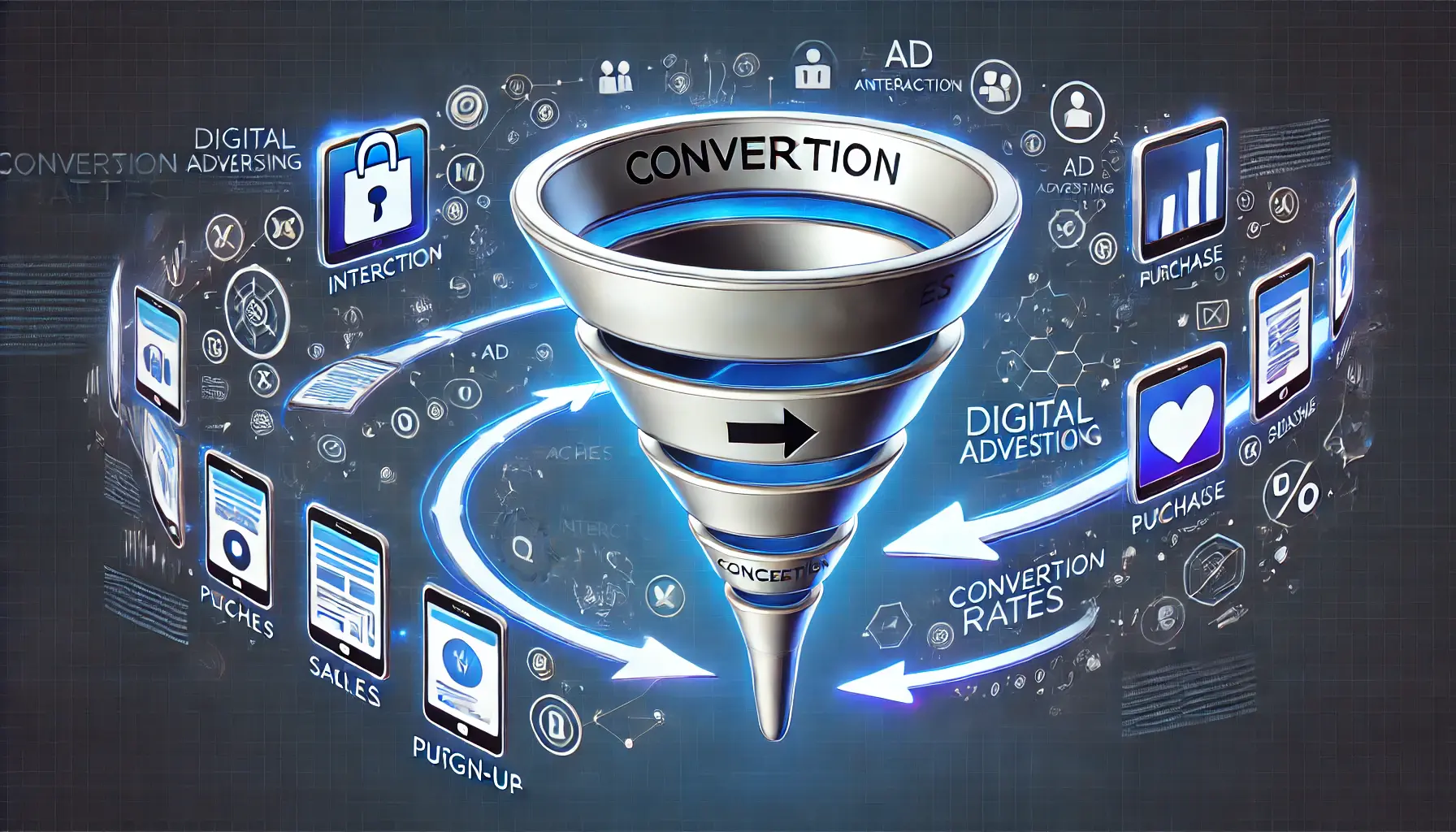
A visual representation of conversion rates in digital advertising, illustrating the flow of users through the conversion funnel.
Conversion Rates
The conversion rate measures the percentage of ad clicks that result in a specific action, such as making a purchase or signing up.
Current averages are as follows:
- Google Ads: Approximately 3.75% conversion rate.
- Bing Ads: Around 2.95% conversion rate.
While Google Ads leads in conversion rates, Bing Ads performs competitively, making it a strong alternative depending on your audience and industry.
To optimize your strategy, understanding these performance metrics is essential.
In the next section, we’ll provide strategic recommendations for advertisers to effectively utilize both platforms.
Bing Ads often sees higher CTR due to less saturated ad space, whereas Google Ads leads in overall conversion rates. Balance these metrics based on your campaign goals.
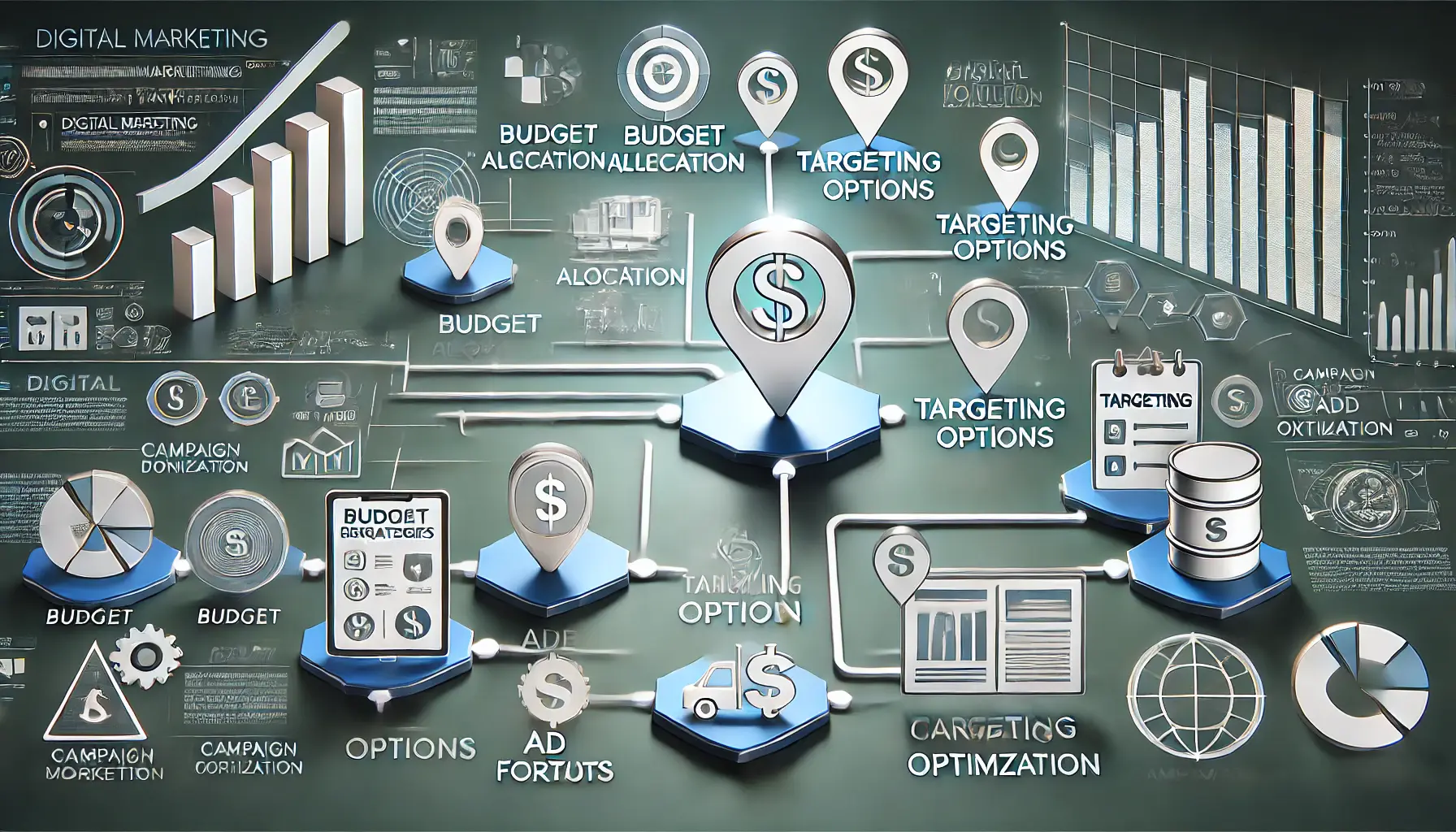
A visual representation of strategic recommendations for advertisers, highlighting key marketing strategies like budget allocation, targeting, and ad formats.
Strategic Recommendations for Advertisers
When deciding between Bing Ads vs Google Ads, it’s essential to align your advertising strategy with your business objectives, target audience, and budget constraints.
Here are strategic recommendations to help you leverage each platform effectively:

A visual representation of the process of assessing a target audience in digital marketing, highlighting different demographics and data analysis.
1. Assess Your Target Audience
Understanding the demographics of your audience is crucial:
- Bing Ads: Tends to attract an older, more affluent user base, making it suitable for industries targeting professionals or higher-income groups.
- Google Ads: Offers a diverse and extensive audience, ideal for campaigns aiming for broad reach across various demographics.

A visual representation of evaluating cost-effectiveness in digital advertising, highlighting the balance between cost and return on investment.
2. Evaluate Cost-Effectiveness
Consider your budget and the cost dynamics of each platform:
- Bing Ads: Generally offers lower cost-per-click (CPC) due to less competition, providing a cost-effective option for advertisers with limited budgets.
- Google Ads: While offering broader reach, it often comes with higher CPCs, necessitating a more substantial budget for competitive keywords.

A visual representation of leveraging unique features in digital marketing, highlighting advanced tools like LinkedIn Profile Targeting and custom ad formats.
3. Leverage Unique Features
Utilize the distinctive features of each platform to enhance your campaigns:
- Bing Ads: Offers LinkedIn Profile Targeting, allowing precise B2B marketing by targeting users based on their professional profiles.
- Google Ads: Provides advanced machine learning capabilities and a vast network, enabling sophisticated targeting and extensive reach.

A visual representation of implementing a dual-platform strategy in digital advertising, highlighting the use of both Google Ads and Bing Ads.
4. Implement a Dual-Platform Strategy
Maximize your advertising potential by running campaigns on both platforms:
- Monitor and analyze performance metrics from both Bing Ads and Google Ads to determine which platform performs better for your goals.
- Dynamically allocate funds based on performance data, directing more budget towards the platform yielding higher returns.

A visual representation of monitoring and adapting to industry changes in digital marketing, highlighting market trends, analytics, and adjustments.
5. Monitor and Adapt to Industry Changes
Familiarize yourself with changes and updates to policies that may affect your campaigns:
- For instance, Google’s recent decision to maintain third-party cookies with user consent highlights the importance of adapting to privacy-related changes in advertising strategies.
By considering these strategic recommendations, you can effectively navigate the Bing Ads vs Google Ads landscape, optimizing your campaigns to achieve your marketing objectives.
Leverage both platforms strategically. Use Bing Ads for cost-efficient campaigns targeting professionals and Google Ads for broader reach and higher conversions.
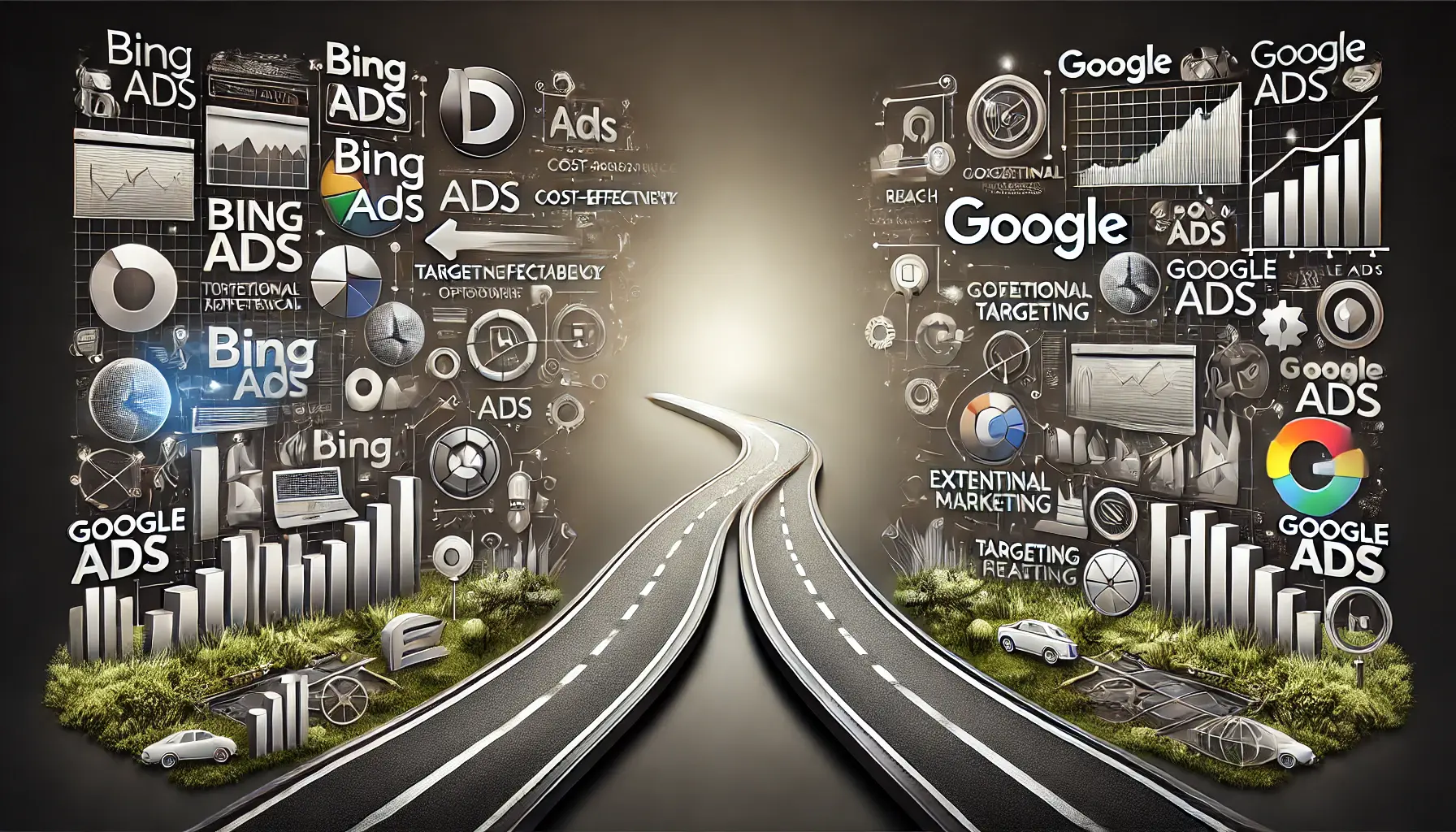
A visual summary comparing Bing Ads and Google Ads, highlighting cost-effectiveness, targeting, and global reach for both platforms.
Summary: Key Takeaways on Bing Ads vs Google Ads
The comparison of Bing Ads vs Google Ads offers valuable insights for advertisers aiming to maximize their digital marketing efforts.
Each platform comes with unique strengths and limitations, making it important to tailor your approach based on your business objectives, target audience, and budget.

A visual representation of the strengths of Bing Ads and Google Ads, highlighting Bing’s cost-effectiveness and Google’s global reach.
Understanding Their Strengths
Google Ads dominates the market with its expansive reach, advanced targeting options, and integration with platforms like YouTube.
This makes it a prime choice for advertisers seeking broad exposure and higher conversion rates.
However, the higher cost-per-click (CPC) often requires a larger advertising budget.
Bing Ads, on the other hand, is more economical than Google Ads, offering lower CPCs and a more targeted audience.
One of its exclusive features, LinkedIn Profile Targeting, makes it particularly useful for B2B campaigns and targeting affluent professionals and advertisers.

A visual representation of the importance of key metrics in digital marketing, emphasizing CTR, conversion rates, and cost-per-click.
Key Metrics Matter
Performance metrics like click-through rates (CTR) and conversion rates further highlight the strengths of each platform.
Bing Ads often demonstrates higher engagement levels due to less saturated ad space, while Google Ads leads in overall conversions thanks to its larger audience base.

A visual representation of strategic recommendations in digital marketing, highlighting different approaches like budget allocation, targeting, and optimization.
Strategic Recommendations
For advertisers looking to leverage both platforms effectively, the following strategies are recommended:
- Analyze audience demographics to determine which platform aligns with your target market.
- Allocate budgets strategically, leveraging Bing Ads for cost-efficient campaigns and Google Ads for extensive reach.
- Utilize each platform’s unique features to enhance campaign performance, such as LinkedIn Profile Targeting on Bing Ads and advanced machine learning on Google Ads.
- Consider a dual-platform approach to maximize returns, dynamically adjusting budgets based on performance metrics.
- Stay updated on industry changes and policy updates to adapt your advertising strategies effectively.

A visual representation of final thoughts and conclusions in digital marketing, with a focus on careful analysis and strategy evaluation.
Final Thoughts
Ultimately, the choice between Bing Ads vs Google Ads depends on your specific goals and resources.
By understanding the unique advantages of each platform and implementing data-driven strategies, you can optimize your campaigns for maximum impact.
Both platforms offer immense potential for advertisers, making them valuable tools in a comprehensive digital marketing strategy.
Understanding the unique strengths of Bing Ads and Google Ads allows you to create a balanced and effective digital marketing strategy.
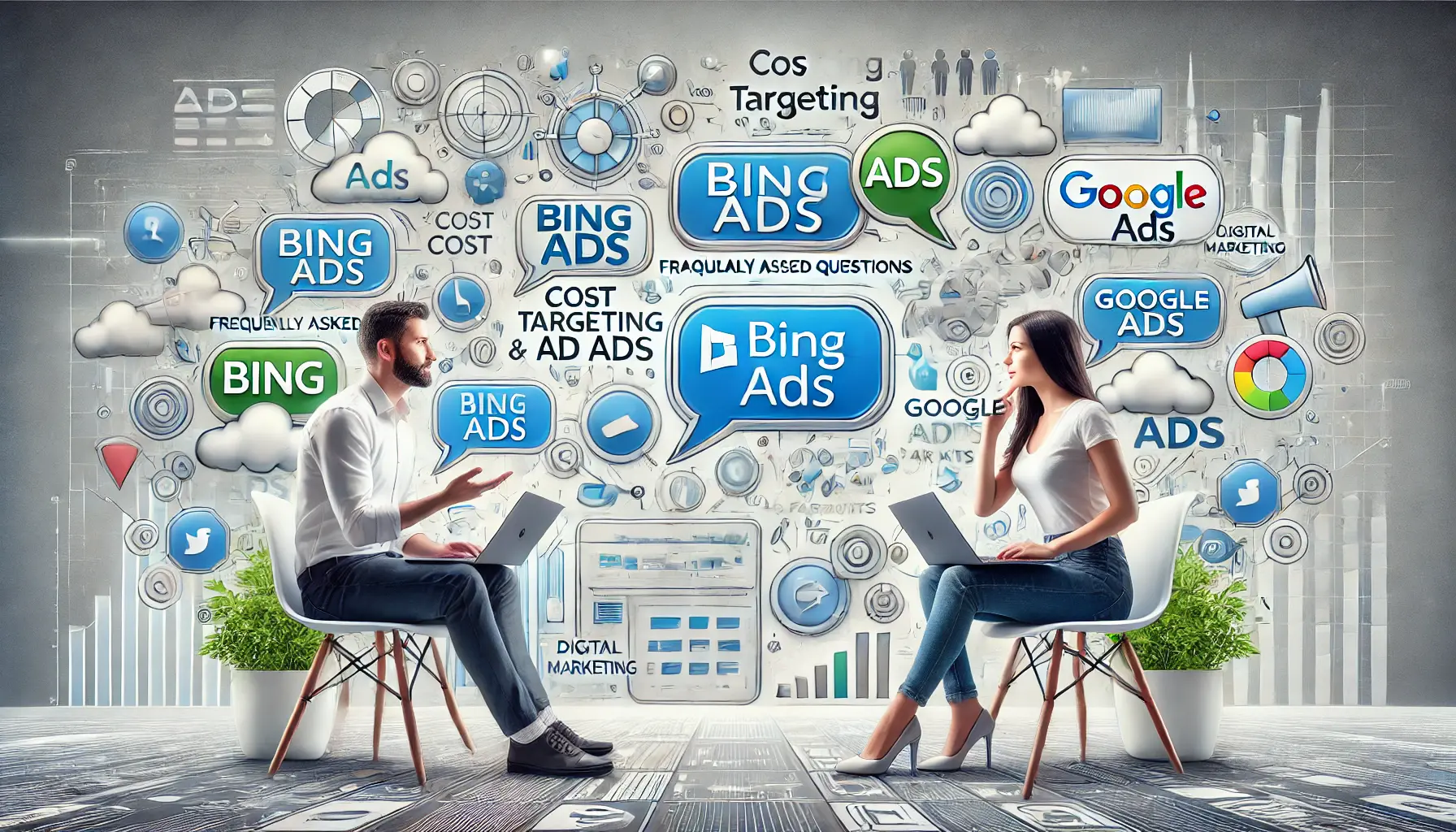
A visual representation of frequently asked questions about Bing Ads and Google Ads, highlighting common topics like cost, targeting, and ad formats.
Your campaigns can be managed by an agency specialized in Google Ads, check out our service page.
Frequently Asked Questions about Bing Ads vs Google Ads
In this section, we address common queries regarding the comparison of Bing Ads vs Google Ads to help you make informed advertising decisions.
Bing Ads, now Microsoft Advertising, serves ads on Bing, Yahoo, and AOL, while Google Ads displays on Google Search, YouTube, and the Google Display Network.
Each platform offers unique features and audience reach.
Google Ads has a larger audience due to Google’s dominance in the search engine market.
Bing Ads, however, can still reach a significant number of users, especially in certain demographics.
Generally, the cost per click (CPC) is lower on Bing Ads compared to Google Ads.
This can make Bing a more cost-effective option for some businesses.
Yes, using both platforms can help you reach a broader audience and maximize your ad spend.
Each has unique strengths that can complement your advertising strategy.
Both platforms offer robust targeting options, but Google Ads provides more advanced features like custom intent audiences and detailed demographic targeting.
Assess your target audience, budget, and advertising goals.
Google Ads offers broader reach, while Bing Ads may provide cost advantages and unique features like LinkedIn profile targeting.
Yes, Bing Ads has LinkedIn profile targeting.
With Bing Ads, advertisers can target users based on their professional information, which is very useful in B2B campaigns.
Yes, Bing Ads tends to have older, more affluent users compared to the broader and more varied audience of Google Ads.
Understanding these demographics can help tailor your advertising strategy.
ROI depends on various factors, including your industry, target audience, and campaign optimization.
Analyzing performance metrics on both platforms can help determine which yields better results for your business.






